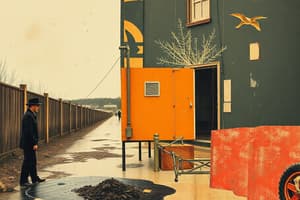Podcast
Questions and Answers
According to the text, what is the purpose of this guideline?
According to the text, what is the purpose of this guideline?
- To establish a safe work area upon arrival at the incident
- To define the operational procedures for limited size fluid spills involving motorized vehicles and other hazards (correct)
- To comply with the Hazardous Materials guidelines and/or authorities
- To address spills that are beyond the capability of a properly stocked single apparatus
Who is responsible for reviewing this guideline annually and ensuring its accuracy?
Who is responsible for reviewing this guideline annually and ensuring its accuracy?
- The Fire Chief or designee (correct)
- The appropriate Hazardous Materials guidelines and/or authorities
- All Spring Fire Department personnel
- The Harris County HazMat Team
What type of fluids does this guideline specifically address?
What type of fluids does this guideline specifically address?
- All types of fluids regardless of the source
- Fluids that have the potential to cause adverse environmental impacts
- Fluids from motor vehicles, such as diesel, gasoline, coolant, motor oil, transmission fluid, etc. (correct)
- Fluids from hazardous materials incidents
If a spill is beyond the capability of a properly stocked single apparatus, what will happen?
If a spill is beyond the capability of a properly stocked single apparatus, what will happen?
What must be done upon arrival at the incident?
What must be done upon arrival at the incident?
Who is responsible for knowing and complying with this guideline?
Who is responsible for knowing and complying with this guideline?
What should be considered upon arrival at the incident?
What should be considered upon arrival at the incident?
What is the document number of this guideline?
What is the document number of this guideline?
What is the revision number of this guideline?
What is the revision number of this guideline?
What is the date of this guideline?
What is the date of this guideline?
Which of the following materials can be used to mitigate spills on roadways or driving surfaces?
Which of the following materials can be used to mitigate spills on roadways or driving surfaces?
Who is responsible for disposing of absorbent materials used to mitigate spills?
Who is responsible for disposing of absorbent materials used to mitigate spills?
Where should contaminated materials be placed for proper mitigation, remediation, and disposal?
Where should contaminated materials be placed for proper mitigation, remediation, and disposal?
Can contaminated materials be taken into the possession of SFD or transported to any SFD fire station or facility?
Can contaminated materials be taken into the possession of SFD or transported to any SFD fire station or facility?
How should Stardust be applied to absorb fluid spills?
How should Stardust be applied to absorb fluid spills?
What should be done with the spent absorbent on a large spill where it becomes saturated?
What should be done with the spent absorbent on a large spill where it becomes saturated?
What precautions should be taken when using Stardust to absorb fluid spills?
What precautions should be taken when using Stardust to absorb fluid spills?
What must be done with the collected materials and contaminated PPE that cannot be decontaminated in case of biohazard/bloodborne pathogen material spills?
What must be done with the collected materials and contaminated PPE that cannot be decontaminated in case of biohazard/bloodborne pathogen material spills?
What is the recommended way to transport the collected materials and contaminated PPE in case of biohazard/bloodborne pathogen material spills?
What is the recommended way to transport the collected materials and contaminated PPE in case of biohazard/bloodborne pathogen material spills?
What should be done in case of contact with Stardust and mucous membranes?
What should be done in case of contact with Stardust and mucous membranes?
Flashcards are hidden until you start studying
Study Notes
Guideline Purpose and Review
- The purpose of this guideline is to provide a framework for responding to fluid spills.
- The guideline is to be reviewed annually to ensure its accuracy, and the responsible party is not specified.
Fluid Spills and Response
- This guideline specifically addresses fluid spills on roadways or driving surfaces.
- If a spill is beyond the capability of a single apparatus, additional resources will be summoned.
Incident Response and Arrival
- Upon arrival at the incident, responders must assess the situation and take necessary actions.
- Responders must consider the type of fluid, size of the spill, and potential hazards upon arrival.
Responsibility and Compliance
- All personnel are responsible for knowing and complying with this guideline.
Mitigation and Remediation
- Absorbent materials, such as Stardust, can be used to mitigate spills on roadways or driving surfaces.
- The responsible party for disposing of absorbent materials is not specified.
- Contaminated materials should be placed in a designated area for proper mitigation, remediation, and disposal.
- Contaminated materials cannot be taken into possession of SFD or transported to any SFD fire station or facility.
Stardust Application and Precautions
- Stardust should be applied liberally to absorb fluid spills, working from the outside in.
- When using Stardust, precautions should be taken to avoid contact with skin and mucous membranes.
- In case of contact with Stardust and mucous membranes, flush with water and seek medical attention if irritation persists.
Large Spills and Biohazard Spills
- On large spills where the absorbent becomes saturated, the spent absorbent should be removed and replaced with fresh absorbent.
- In case of biohazard/bloodborne pathogen material spills, the collected materials and contaminated PPE that cannot be decontaminated should be placed in a biohazard bag and sealed.
- The recommended way to transport the collected materials and contaminated PPE is in a sealed biohazard bag.
Document Information
- The document number of this guideline is not specified.
- The revision number of this guideline is not specified.
- The date of this guideline is not specified.
Studying That Suits You
Use AI to generate personalized quizzes and flashcards to suit your learning preferences.



